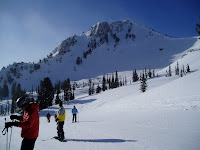It's Friday - I've almost made it through another work week. In my email this morning I received a collection of very wise quotes from a collegue here at the office. I wanted to share this with you.
"A slipping gear could let your M203 grenade launcher fire when youleast expect it. That would make you quite unpopular in what's leftof your unit."
- Army's magazine of preventive maintenance.
---------------------------------------------------
"Aim towards the Enemy"
- Instructions printed on U.S. Rocket Launcher
---------------------------------------------------
"When the pin is pulled, Mr. Grenade is not our friend."
- U.S. Marine Corps
---------------------------------------------------
"Cluster bombing from B-52s is very, very accurate. The bombs are guaranteed always to hit the ground."
- USAF Ammo Troop
---------------------------------------------------
"If the Enemy is in range, so are you."
- Infantry Journal
---------------------------------------------------
"It is generally inadvisable to eject over the area you just bombed"
- U.S. Air Force Manual
---------------------------------------------------
"Whoever said the pen is mightier then the sword obviously never encountered automatic weapons."
- General MacArthur
---------------------------------------------------
"Try to look unimportant; they may be low on ammo."
- Infantry Journal
---------------------------------------------------
"You, you, and you. Panic. The rest of you come with me."
- (Marine Corps Master Gunnery Sergeants ROCK!) - U.S. Marine Gunnery Sgt. (Mgysgt5)
----------------------------------------------------
"Tracers work both ways."
- U.S. Army Ordnance
----------------------------------------------------
"Five second fuses only last three seconds"
- Infantry Journal
----------------------------------------------------
"Don't ever be the first, don't ever be the last, and don't ever volunteer to do anything."
- U.S. Navy Swabbie
----------------------------------------------------
"Bravery is being the only one who knows you're afraid."
- David Hackworth
-----------------------------------------------------
"If your attack is going too well, you're walking into an ambush."
- Infantry Journal
-----------------------------------------------------
"No combat-ready unit has ever passed inspection."
- Joe Gay
------------------------------------------------------
"Any ship can be a minesweeper. Once."
- unknown
------------------------------------------------------
"Never tell the Platoon Sergeant you have nothing to do."
- Unknown Marine Recruit
-------------------------------------------------------
"Don't draw fire; it irritates the people around you."
-------------------------------------------------------
"If you see a bomb technician running, follow him and try to keep up."
- USAF Ammo Troop
------------------------------------------------------
"You've never been lost until you've been lost at Mach 3."
- Paul F. Crickmore (test pilot)
-------------------------------------------------------
"The only time you have too much fuel is when you're on fire."
-------------------------------------------------------
"Blue water Navy truism: There are more planes in the ocean than submarines in the sky." - From an old carrier sailor
------------------------------------------------------
"If the wings are traveling faster than the fuselage, it's probably a helicopter -- and therefore, unsafe."
-------------------------------------------------------
"When one engine fails on a twin-engine airplane, you always have enough power left to get you to the scene of the crash."
-------------------------------------------------------
"Without munitions, the USAF would be just another expensive flyingclub.
" -------------------------------------------------------
"What is the similarity between air traffic controllers and pilots? If a pilot screws up, the pilot dies; If ATC screws up.... The pilot dies."
-------------------------------------------------------
"Never trade luck for skill."
-------------------------------------------------------
The three most common expressions (or famous last words) in aviationare: "Why is it doing that?", "Where are we?" And "Oh S...!"
------------------------------------------------------
"Weather forecasts are horoscopes with numbers."
-------------------------------------------------------
"Airspeed, altitude and brains. Two are always needed to complete theflight successfully."
-------------------------------------------------------
"Mankind has a perfect record in aviation; we've never left one up there!"
-------------------------------------------------------
"Flashlights are tubular metal containers kept in a flight bag to store dead batteries."
-------------------------------------------------------
"Flying the airplane is more important than radioing your flight to aperson on the ground who is incapable of understanding or doinganything about it."
--------------------------------------------------------
"The Piper Cub is the safest airplane in the world; it can justbarely kill you."
- Attributed to Max Stanley (Northrop test pilot)
--------------------------------------------------------
"A pilot who doesn't have any fear probably isn't flying his plane toits maximum."
- Jon McBride, astronaut
--------------------------------------------------------
"If you're faced with a forced landing, fly the thing as far into thecrash as possible."
- Bob Hoover (renowned aerobatic and test pilot )
--------------------------------------------------------
"Never fly in the same cockpit with someone braver than you."
-------------------------------------------------------
"There is no reason to fly through a thunderstorm in peacetime."
- Sign over squadron ops desk at Davis-Monthan AFB, AZ, 1970
---------------------------------------------------------
"If something hasn't broken on your helicopter, it's about to."
--------------------------------------------------------
Basic Flying Rules: "Try to stay in the middle of the air. Do not go near the edges of it. The edges of the air can be recognized by the appearance of ground, buildings, sea, trees and interstellar space.It is much more difficult to fly there."
-------------------------------------------------------
"You know that your landing gear is up and locked when it takes fullpower to taxi to the terminal."
--------------------------------------------------------------
As the test pilot climbs out of the experimental aircraft, havingtorn off the wings and tail in the crash landing, the crash truckarrives, the rescuer sees a bloodied pilot and asks, "What happened?".The pilot's reply, "I don't know, I just got here myself!"












 We added my son Zeke this year. Also on the trip for our visit to Snowbird was Justin - a nephew from Salt Lake City. As of 2008 the SkiPalooza Crew was four (and one-half).
We added my son Zeke this year. Also on the trip for our visit to Snowbird was Justin - a nephew from Salt Lake City. As of 2008 the SkiPalooza Crew was four (and one-half).